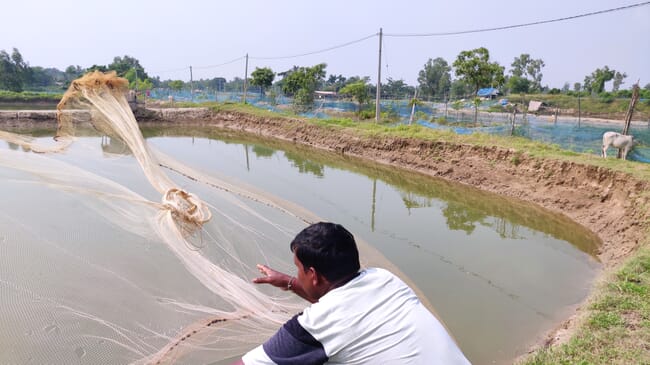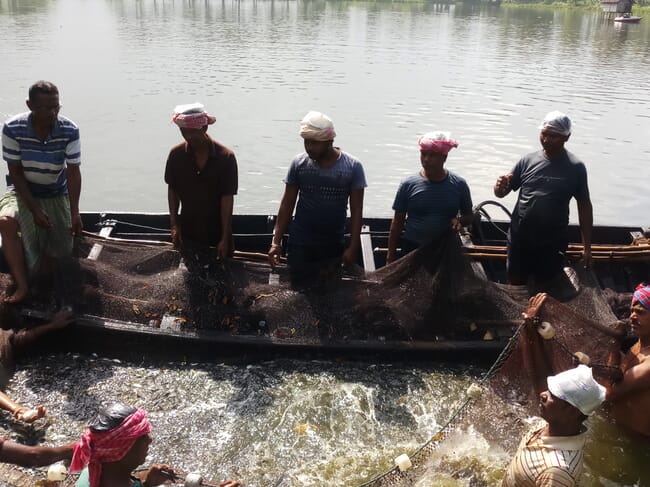Rabindranath Bhuia considers himself lucky. A few weeks ago, the 40-year-old was preparing to cultivate shrimp at his 1-acre pond at Baguran Jalpai village, in West Bengal’s East Midnapore district. But he dropped his plan after the Indian prime minister, Narendra Modi, declared a three-week lockdown across the country on 24 March, to try to contain the spread of coronavirus. Bhuia thought better of an up-front investment in shrimp, and instead decided to save money for a future that suddenly seemed so much more uncertain thanks to the pandemic.

© Gurvinder Singh
Farmers fear severe losses in India
But not all farmers have been as fortunate as Bhuia. Around 80 percent of all farmers in Baguran Jalpai, which is close to the Bay of Bengal, have switched to shrimp cultivation over the years because of relatively high returns. But fears of losing all their hard-earned income at a single stroke have been growing with the spread of Covid-19.
Sunil Mahata, 36, a shrimp farmer who lives in the village, expects heavy losses if the situation doesn’t change in the next few months. “I invested around ₹ 5 lakhs (US$6,500) for 2 lakhs (200,000) shrimp seeds [post-larvae] just 10 days before the lockdown was announced. I have to spend money to feed them and also on medicines. I am spending sleepless nights as buyers might not turn up if the situation remains the same or takes a turn for worse.”
The worries expressed by this small group of farmers in Bengal is typical of the gloom taking hold across the Indian seafood industry. Operators both big and small have been left struggling because of the severe spread of the virus in European countries that have been the major buyers of Indian seafood over the years.
India is the second largest fish producer in the world, with a total production of 13.7 million tonnes in 2018-19 – of which 65 percent came from the inland sector. Almost 50 percent of inland fish production is from aquaculture, with India's freshwater fish landings (from both aquaculture and capture fisheries) constituting 6.5 percent of global fish landings. The industry employs over 16 million people in the seafood business.
European buyers might be forced to reduce orders
Exporters fear that major buyers like France, Italy, Spain, the USA and Portugal – who have all seen soaring numbers of deaths related to Covid-19 – might be forced to tighten their purses, as once the pandemic subsides their economies will take a long time to recover.
“It is going to get worse as the exports were already down since February when China got badly hit by the pandemic,” said Ganesh Nakhawa, chair of West Coast Purse Seine Fishing Welfare Association. “It became more severe by the first week of March, when European countries also stopped import of sea food from India. The cold storages were full of seafood and the small players were forced to sell their seafood at 10 percent of the cost. Large quantities of seafood were destroyed because of no storage place.”
In 2018-19, India exported 1.39 million tonnes of marine products, worth more than US $6.7 billion. The USA was the major importer of Indian seafood, accounting for 32.76 percent of the value, followed by South East Asia, the European Union, Japan, the Middle-East and China. Exactly how these export markets will be affected by the coronavirus in the figures for 2019-20 remains to be seen, but the outlook isn't wildly encouraging.
Government assures of early revival
Sensing the seriousness of the situation and its impact on Indian fishermen, various trade unions wrote to the Indian government asking the government to waive loans to small scale-fish producers and to provide the with financial support. The unions also demanded the distribution of face masks to ensure the safety of seafood workers, as well as training in social distancing.
Subsequently, on 10 April, the Indian government passed a measure that allowed marine fishing, with social distancing. “The order passed by the government would hardly improve the condition of the fishermen,” said Debasis Shyamal, council member of the National Platform for Small Scale Fish Workers, “as tonnes of seafood are already stocked in the cold storages due to the lockdown. The exports are also shut. The local markets are also not opening. The question is: what they would do with the catch?”
The government, however, says that is taking necessary steps to ensure trade revives as early as possible. “We have already seen the notification of the central government,” said Chandranath Singha, the minister in charge of the West Bengal fisheries department. “We are now trying to regularise the marine trade. We would also ensure that social distancing is maintained among the fishermen.”

Monsoon ban could hit the trade further
Experts say that the monsoon season could be another dampener for the seafood industry.
“The export market in the marine sector has been disrupted heavily because the lockdown was announced at very short notice without any prior information,” said Siddharth Chakravarty from The Research Collective, a civil-society organisation working with communities relying on natural resources for survival. “It has come at an unfortunate time since it narrowly precedes the scheduled monsoon ban on the east and west coasts. The east coast would be under the ban period from 15 April to15 June, and the west coast from 15 June to August. As a result, there would be no fishing for the next five to six months.”
Chakravarty continued: “The coronavirus outbreak is another blow to the marine industry that also suffered immensely last year when natural cyclones and the climate crisis hampered fishing at sea. The sector is under severe financial stress and a bailout package is required to help fishing resume. Some big exporters have already stopped operations till the condition stabilises. It might also impact supply chains since the process from production to consumption is a highly globalised one and currently not within the policy scope of one nation alone.”
A section of exporters, however, feel that it would be too early to make any predictions. “It is a stocking season of shrimps in West Bengal and the raw material starts to be harvested from the end of April, with a peak harvest season normally in June to July. However, this year seed stocking is too low and harvests may resume from June onwards,” suggested a senior official of a major export company in eastern India on condition of anonymity.
“It’s still months to go but undoubtedly production will not be the same as before, as farmers have become reluctant to invest in shrimp because of the present situation. The shrimps are mostly used in hotel and restaurants across the globe, but [the sector] might take a hit. On the brighter side, the situation might not be as bad as is being envisaged. We should wait and watch rather than becoming too negative over it,” the exporter added.



